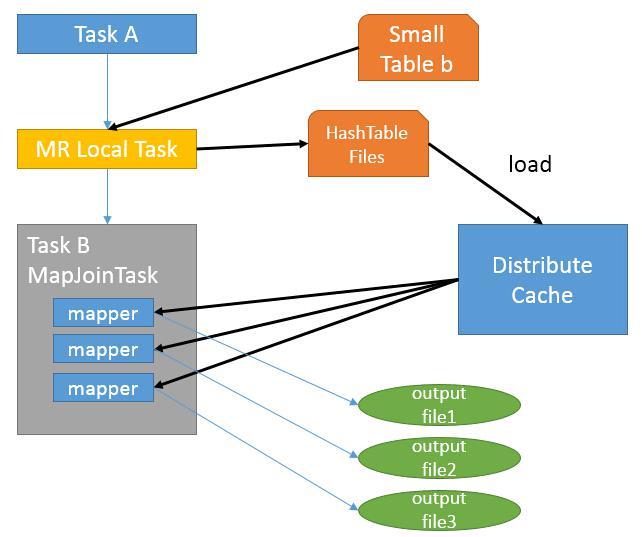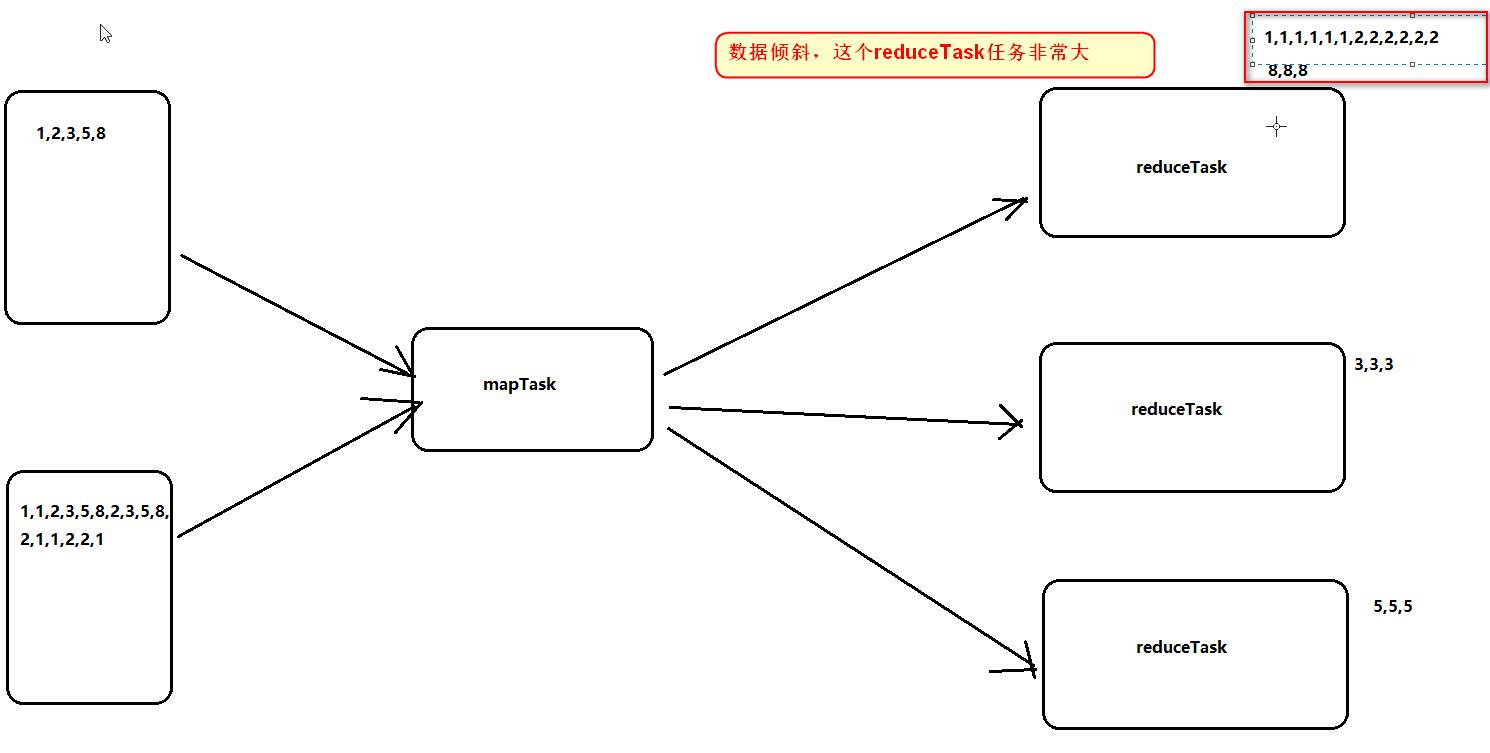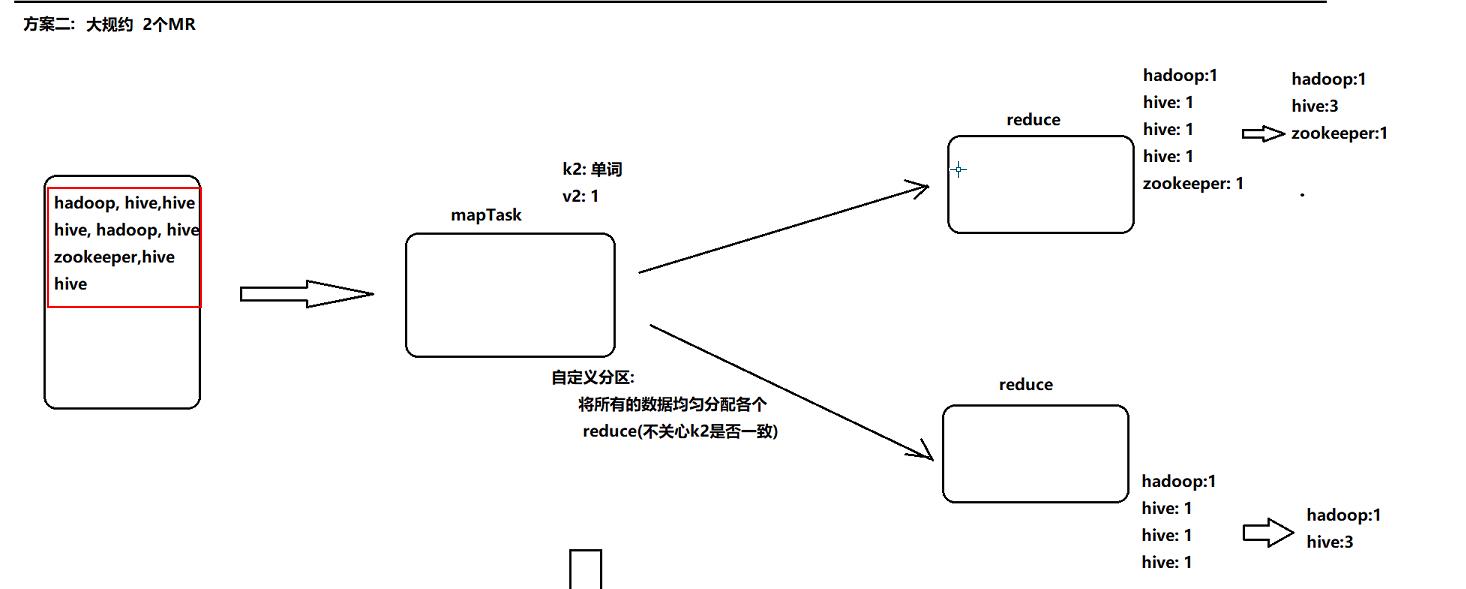大数据面试题:Hive优化措施
Posted Lansonli
tags:
篇首语:本文由小常识网(cha138.com)小编为大家整理,主要介绍了大数据面试题:Hive优化措施相关的知识,希望对你有一定的参考价值。

文章目录
1、通常情况下,作业会通过input的目录产生一个或者多个map任务。
3、是不是保证每个map处理接近128m的文件块,就高枕无忧了?
Hive优化措施
一、Fetch抓取
Fetch抓取是指 Hive中对某些情况的查询可以不必使用MapReduce计算 。例如:SELECT * FROM employees; 在这种情况下,Hive可以简单地读取employee对应的存储目录下的文件,然后输出查询结果到控制台。 在hive-default.xml.template文件中hive.fetch.task.conversion默认是more,老版本hive默认是 minimal,该属性修改为more以后,在全局查找、字段查找、limit查找等都不走mapreduce。<property>
<name>hive.fetch.task.conversion</name>
<value>more</value>
<description>
Expects one of [none, minimal, more]. Some select queries can be converted to single FETCH task minimizing latency. Currently the query should be single sourced not having any subquery and should not have any aggregations or distincts (which incurs RS), lateral views and joins. 0. none : disable hive.fetch.task.conversion
1. minimal : SELECT STAR, FILTER on partition columns, LIMIT only
2. more : SELECT, FILTER, LIMIT only (support TABLESAMPLE and virtual columns)
</description>
</property>案例实操:
1)把hive.fetch.task.conversion设置成none,然后执行查询语句,都会执行mapreduce程序。hive (default)> set hive.fetch.task.conversion=none;
hive (default)> select * from emp;
hive (default)> select ename from emp;
hive (default)> select ename from emp limit 3;hive (default)> set hive.fetch.task.conversion=more;
hive (default)> select * from emp;
hive (default)> select ename from emp;
hive (default)> select ename from emp limit 3;二、本地模式
大多数的Hadoop Job是需要Hadoop提供的完整的可扩展性来处理大数据集的。不过,有时Hive的输入数据量是非常小的。在这种情况下,为查询触发执行任务时消耗可能会比实际job的执行时间要多的多。对于大多数这种情况,Hive可以通过本地模式在单台机器上处理所有的任务。对于小数据集,执行时间可以明显被缩短。 用户可以通过设置hive.exec.mode.local.auto的值为true,来让Hive在适当的时候自动启动这个优化。set hive.exec.mode.local.auto=true; //开启本地mr
//设置local mr的最大输入数据量,当输入数据量小于这个值时采用local mr的方式,默认为
134217728,即128M
set hive.exec.mode.local.auto.inputbytes.max=50000000;
//设置local mr的最大输入文件个数,当输入文件个数小于这个值时采用local mr的方式,默认为4
set hive.exec.mode.local.auto.input.files.max=10;hive (default)> set hive.exec.mode.local.auto=true;
hive (default)> select * from emp cluster by deptno;
Time taken: 1.328 seconds, Fetched: 14 row(s)hive (default)> set hive.exec.mode.local.auto=false;
hive (default)> select * from emp cluster by deptno;
Time taken: 20.09 seconds, Fetched: 14 row(s)三、表的优化
1、小表、大表Join
将key相对分散,并且数据量小的表放在join的左边,这样可以有效减少内存溢出错误发生的几率;再进一步,可以使用Group让小的维度表(1000条以下的记录条数)先进内存。在map端完成reduce。 实际测试发现:新版的hive已经对小表JOIN大表和大表JOIN小表进行了优化。小表放在左边和右边已经没有明显区别。 案例实操 需求:测试大表JOIN小表和小表JOIN大表的效率 1.1、建大表、小表和JOIN后表的语句create table bigtable(id bigint, time bigint, uid string, keyword string, url_rank int, click_num int, click_url string) row format delimited fields terminated by '\\t';
create table smalltable(id bigint, time bigint, uid string, keyword string, url_rank int, click_num int, click_url string) row format delimited fields terminated by '\\t';
create table jointable(id bigint, time bigint, uid string, keyword string, url_rank int, click_num int, click_url string) row format delimited fields terminated by '\\t';1.2、分别向大表和小表中导入数据
hive (default)> load data local inpath '/opt/module/datas/bigtable' into table bigtable;
hive (default)>load data local inpath '/opt/module/datas/smalltable' into table smalltable;1.3、关闭map join功能(默认是打开的)
set hive.auto.convert.join = false;1.4、执行小表JOIN大表语句
insert overwrite table jointable
select b.id, b.time, b.uid, b.keyword, b.url_rank, b.click_num, b.click_url
from smalltable s
left join bigtable b
on b.id = s.id;insert overwrite table jointable
select b.id, b.time, b.uid, b.keyword, b.url_rank, b.click_num, b.click_url
from bigtable b
left join smalltable s
on s.id = b.id;2、大表Join大表
2.1、空KEY过滤 有时join超时是因为某些key对应的数据太多,而相同key对应的数据都会发送到相同的reducer上,从而导致内存不够。此时我们应该仔细分析这些异常的key,很多情况下,这些key对应的数据是异常数据,我们需要在SQL语句中进行过滤。例如key对应的字段为空,操作如下: 案例实操: 2.1.1、配置历史服务器 配置mapred-site.xml<property>
<name>mapreduce.jobhistory.address</name>
<value>hadoop102:10020</value>
</property>
<property>
<name>mapreduce.jobhistory.webapp.address</name>
<value>hadoop102:19888</value>
</property>sbin/mr-jobhistory-daemon.sh start historyservercreate table ori(id bigint, time bigint, uid string, keyword string, url_rank int, click_num int, click_url string) row format delimited fields terminated by '\\t';
create table nullidtable(id bigint, time bigint, uid string, keyword string, url_rank int, click_num,int, click_url string) row format delimited fields terminated by '\\t';
create table jointable(id bigint, time bigint, uid string, keyword string, url_rank int, click_num int, click_url string) row format delimited fields terminated by '\\t';2.1.3、分别加载原始数据和空id数据到对应表中
hive (default)> load data local inpath '/opt/module/datas/ori' into table ori;
hive (default)> load data local inpath '/opt/module/datas/nullid' into table nullidtable;2.1.4、测试不过滤空id
hive (default)> insert overwrite table jointable
select n.* from nullidtable n left join ori o on n.id = o.id;hive (default)> insert overwrite table jointable
select n.* from (select * from nullidtable where id is not null ) n left join ori o on n.id = o.id;Time taken: 31.725 seconds
2.2、空key转换
有时虽然某个key为空对应的数据很多,但是相应的数据不是异常数据,必须要包含在join的结果中,此时我们可以表a中key为空的字段赋一个随机的值,使得数据随机均匀地分不到不同的reducer上。例如: 案例实操: 2.2.1、不随机分布空null值 1)设置5个reduce个数set mapreduce.job.reduces = 5;insert overwrite table jointable
select n.* from nullidtable n left join ori b on n.id = b.id;set mapreduce.job.reduces = 5;insert overwrite table jointable
select n.* from nullidtable n full join ori o on
case when n.id is null then concat('hive', rand()) else n.id end = o.id;3、MapJoin
如果不指定MapJoin或者不符合MapJoin的条件,那么Hive解析器会将Join操作转换成Common Join,即:在Reduce阶段完成join。容易发生数据倾斜。可以用MapJoin把小表全部加载到内存在map端进行join,避免reducer处理。 3.1、开启MapJoin参数设置 1)设置自动选择Map joinset hive.auto.convert.join = true; 默认为true2)大表小表的阀值设置(默认25M一下认为是小表):
set hive.mapjoin.smalltable.filesize=25000000;3.2、MapJoin工作机制

set hive.auto.convert.join = true; 默认为trueinsert overwrite table jointable
select b.id, b.time, b.uid, b.keyword, b.url_rank, b.click_num, b.click_url
from smalltable s
join bigtable b
on s.id = b.id;insert overwrite table jointable
select b.id, b.time, b.uid, b.keyword, b.url_rank, b.click_num, b.click_url
from bigtable b
join smalltable s
on s.id = b.id;4、Group By
默认情况下,Map阶段同一Key数据分发给一个reduce,当一个key数据过大时就倾斜了。 并不是所有的聚合操作都需要在Reduce端完成,很多聚合操作都可以先在Map端进行部分聚合,最后在Reduce端得出最终结果。 4.1、开启Map端聚合参数设置 1)是否在Map端进行聚合,默认为Truehive.map.aggr = true hive.groupby.mapaggr.checkinterval = 100000 hive.groupby.skewindata = true5、Count(Distinct) 去重统计
数据量小的时候无所谓,数据量大的情况下,由于COUNT DISTINCT操作需要用一个Reduce Task来完成,这一个Reduce需要处理的数据量太大,就会导致整个Job很难完成,一般COUNT DISTINCT使用先GROUP BY再COUNT的方式替换: 案例实操: 1)创建一张大表hive (default)> create table bigtable(id bigint, time bigint, uid string, keyword string, url_rank int, click_num int, click_url string) row format delimited fields terminated by '\\t';hive (default)> load data local inpath '/opt/module/datas/bigtable' into table bigtable;set mapreduce.job.reduces = 5;hive (default)> select count(distinct id) from bigtable;Stage-Stage-1: Map: 1 Reduce: 1
Cumulative CPU: 7.12 sec
HDFS Read: 120741990 HDFS Write:
7 SUCCESS
Total MapReduce CPU Time Spent: 7 seconds 120 msec
OK
c0
100001
Time taken: 23.607 seconds, Fetched: 1 row(s)
Time taken: 34.941 seconds, Fetched: 1 row(s)hive (default)> select count(id) from (select id from bigtable group by id) a;Stage-Stage-1: Map: 1 Reduce: 5 Cumulative CPU: 17.53 sec HDFS Read: 120752703 HDFS Write: 580 SUCCESS
Stage-Stage-2: Map: 3 Reduce: 1 Cumulative CPU: 4.29 sec HDFS Read: 9409 HDFS Write: 7 SUCCESS
Total MapReduce CPU Time Spent: 21 seconds 820 msec
OK
_c0
100001
Time taken: 50.795 seconds, Fetched: 1 row(s)6、笛卡尔积
尽量避免笛卡尔积,join的时候不加on条件,或者无效的on条件,Hive只能使用1个reducer来完成笛卡尔积。7、行列过滤
列处理:在SELECT中,只拿需要的列,如果有,尽量使用分区过滤,少用SELECT *。 行处理:在分区剪裁中,当使用外关联时,如果将副表的过滤条件写在Where后面,那么就会先全表关联,之后再过滤,比如: 案例实操: 1)测试先关联两张表,再用where条件过滤hive (default)> select o.id from bigtable b
join ori o on o.id = b.id
where o.id <= 10;hive (default)> select b.id from bigtable b
join (select id from ori where id <= 10 ) o on b.id = o.id;8、动态分区调整
关系型数据库中,对分区表Insert数据时候,数据库自动会根据分区字段的值,将数据插入到相应的分区中, Hive中也提供了类似的机制,即动态分区(Dynamic Partition),只不过,使用Hive的动态分区,需要进行相应的配置。 8.1、开启动态分区参数设置 1)开启动态分区功能(默认true,开启)hive.exec.dynamic.partition=truehive.exec.dynamic.partition.mode=nonstricthive.exec.max.dynamic.partitions=1000hive.exec.max.dynamic.partitions.pernode=100hive.exec.max.created.files=100000hive.error.on.empty.partition=false8.2、案例实操
需求:将ori中的数据按照时间(如:20221230000008),插入到目标表 ori_partitioned_target 的相应分区中。 1)创建分区表create table ori_partitioned(id bigint, time bigint, uid string, keyword string, url_rank int, click_num int, click_url string)
partitioned by (p_time bigint)
row format delimited fields terminated by '\\t';hive (default)> load data local inpath '/opt/module/datas/ds1' into table ori_partitioned
partition(p_time='20221230000010') ;
hive (default)> load data local inpath '/opt/module/datas/ds2' into table ori_partitioned
partition(p_time='20221230000011') ;create table ori_partitioned_target(id bigint, time bigint, uid string, keyword string, url_rank int,click_num int, click_url string) PARTITIONED BY (p_time STRING) row format delimited fields terminated by '\\t';set hive.exec.dynamic.partition = true;
set hive.exec.dynamic.partition.mode = nonstrict;
set hive.exec.max.dynamic.partitions = 1000;
set hive.exec.max.dynamic.partitions.pernode = 100;
set hive.exec.max.created.files = 100000;
set hive.error.on.empty.partition = false;
hive (default)> insert overwrite table ori_partitioned_target partition (p_time);
select id, time, uid, keyword, url_rank, click_num, click_url, p_time from ori_partitioned;hive (default)> show partitions ori_partitioned_target;9、分桶
分桶就是将数据划分到不同的文件,其实就是MapReduce的分区。
10、分区
分区不是独立的表模型,要和内部表或者外部表结合:
- 内部分区表
- 外部分区表
分区可以理解为分类,通过分类把不同类型的数据放到不同的目录下。
分类的标准就是分区字段,可以一个,也可以多个。
分区表的意义在于优化查询。查询时尽量利用分区字段。如果不使用分区字段,就会全部扫描。
在查询是通过where子句查询来指定所需的分区。
在hive中,分区就是分文件夹。
四、数据倾斜
在整个MR执行过程中,有多个reduce程序,多个reduce程序之间处理数据量相差甚远。
数据倾斜的根本原因是数据的key分布不均,个别key数据很多,超出了计算节点的计算能力的结果。
让map节点的输出数据更均匀的分布到reduce节点中去,是解决数据倾斜的最终目标。
思考: 在做什么样操作的时候下 , 会导致有可能出现数据倾斜? join操作 和 group by 1) join
2)group by

1、数据倾斜_join倾斜
解决方案一: 通过 mapjoin 、 bucket mapjoin 以及 smb join 解决方案二: 将那些容易产生数据倾斜的 key 值抽取出来, 使用一个单独的 MR 进行处理即可。 实施方案一:运行时优化 配置:set hive.optimize.skewjoin=true; -- 开启 运行时的join数据倾斜优化
set hive.skewjoin.key=100000; -- 当这个key的值出现多少个的时候, 认为是有数据倾斜的问题注意:
此种优化,如果数据中大多数key都大于了此值,此时不建议开启此优化。如果要使用这个优化,需要调整hive.skewjoin.key此值大小 实施方案二:编译时优化 相关的配置set hive.optimize.skewjoin.compiletime=true; -- 默认关闭CREATE TABLE list_bucket_single (key STRING, value STRING)
-- 倾斜的字段和需要拆分的key值
SKEWED BY (key) ON (1,5,6)
-- 为倾斜值创建子目录单独存放
[STORED AS DIRECTORIES];实际使用中,如何选择呢?
在具体使用时候, 可以两个都开启为 true, 这样当出现了编译期设置的 key 值, 直接抬走; 如果是编译期没有考虑到的值, 在运行过程中 发现了 , 也可以进行优化处理。 我们怎么知道数据倾斜? 1)查看 SQL 执行的时候 , 转换的 MR 是否出现了多个 reduce;
2)查看各个reduce是否有reduce执行时长远远大于其它的reduce;
2、union all的优化
在进行 join 的数据倾斜优化的时候, 不管采用运行时的, 还是编译时, 都是将能产生倾斜的 key 值, 单独拿出来, 使用一个单独 MR 进行处理。 处理后和之前结果进行 union all 合并操作正常情况下,union all 也需要单独运行一个 MR, 将两个结果进行合并, 出现到一个目标目录下在跑一个MR 对效率也会产生影响, 能否不执行 union all 的合并操作呢 , 直接让上面的 MR 直接将结 果输出的目的地。 解决方案 : set hive.optimize.union.remove = true; 此操作一般与数据倾斜 _join 倾斜优化同时开启, 对数据倾斜 _join 倾斜优化最后合并操作进行优化set hive.optimize.skewjoin=true; --开启 运行时的join数据倾斜优化
set hive.skewjoin.key=100000; --当这个key的值出现多少个的时候, 认为是有数据倾斜的问题
set hive.optimize.skewjoin.compiletime=true; -- 开启 编译时的join数据倾斜优化
set hive.optimize.union.remove=true; -- 开启 union all 的优化3、group by的数据倾斜
数据倾斜案例,如图: 方案一:
小规约
开启map端的局部聚合操作(combiner)
方案一:
小规约
开启map端的局部聚合操作(combiner)
配置:hive.map.aggr=true;
原理流程图:

思想:
当选项设定为 true ,生成的查询计划会有两个 MR Job 。第一个 MR Job 中, Map 的输出结果会随机分布到Reduce 中,每个 Reduce 做部分聚合操作,并输出结果,这样处理的结果是相同的 Group By Key 有可能被分发到不同的 Reduce 中,从而达到负载均衡的目的;第二个 MR Job 再根据预处理的数据结果按照Group By Key 分布到 Reduce 中(这个过程可以保证相同的 Group By Key被分布到同一个 Reduce 中),最后完成最终的聚合操作。 使用的注意事项: 如果使用方案二进行 group by 数据倾斜的解决 , 要求 sql 中不允许出现多个列做 distinct 操作, 只能出现一次。 例如 : SELECT ip, count(DISTINCT uid), count(DISTINCT uname) FROMlog GROUP BY ip 此操作就会直接报错, 因为此 sql 中出现多次 distinct 操作 报错内容 : DISTINCT on different columns notsupported with skew in data. 原理流程图: 第一个 MR :先将所有的数据轮询一样分给两个 reduce ,这样就不会有数据倾斜;
第二个MR : 将第一个MR的输出结果作为第二个MR的输入;

总结:
--(1)hive group by 数据倾斜 是否在Map端进行聚合,默认为True
set hive.map.aggr = true;
--(2)在Map端进行聚合操作的条目数目
set hive.groupby.mapaggr.checkinterval = 100000;
--(3)有数据倾斜的时候进行负载均衡(默认是false) group by 数据倾斜,使用两个MR的优化
set hive.groupby.skewindata = true;4、关联优化器
在 hive 执行 sql 的时候, 一个 sql 翻译的 MR 中可能会出现多次 shuffle 操作, 而多次的 shuffle 操作有可能是可以共享的。 此时就可以将 shuffle 进行共享, 从而 减少 shuffle 次数, 提升效率。 如何实施:set hive.optimize.correlation=true;5、总结
-- 以下是hive的并行优化
set hive.driver.parallel.compilation=true --是否开启一次性编译多个sql的功能
set hive.driver.parallel.compilation.global.limit=3 ----表示一次性最多同时有三个会话编
译sql
set hive.exec.parallel=true; --开启hive的并行执行
set hive.exec.parallel.thread.number=16; --表示一次性一个sql中最大运行并行的数量
-- 以下是hive的小文件合并优化
set hive.merge.mapfiles = true ; -- 开启hive的map端小文件合并
set hive.merge.mapredfiles= true; -- 开启hive的reduce端小文件合并
hive.merge.size.per.task: 表示合并后的文件的大小 默认值为 268435456(256M)
hive.merge.smallfiles.avgsize: 表示当输出文件的平均大小小于此设置值时,启动一个独立的mapreduce任务进行文件merge,默认值为16M。
set hive.exec.orc.zerocopy=true; -- hive的读取零拷贝
set hive.vectorized.execution.enabled=true; -- hive的矢量化的查询优化
-- 以下是hive 的join操作数据倾斜优化
set hive.optimize.skewjoin=true; --开启 运行时的join数据倾斜优化
set hive.skewjoin.key=100000; --当这个key的值出现多少个的时候, 认为是有数据倾斜的问题
set hive.optimize.skewjoin.compiletime=true; -- hive的 开启 编译时的join数据倾斜优化
set hive.optimize.union.remove=true; -- hive union all的优化方案
-- 以下是hive 的 group by 操作数据倾斜优化
set hive.map.aggr=true; -- hive group by 数据倾斜 map端局部聚合优化
set hive.groupby.skewindata=true; -- hive的 group by 数据倾斜,使用两个MR的优化
-- hive的关联优化器
set hive.optimize.correlation=true; -- hive的关联优化器 减少shuffle次数五、Map数
1、通常情况下,作业会通过input的目录产生一个或者多个map任务。
主要的决定因素有:input的文件总个数,input的文件大小,集群设置的文件块大小。2、是不是map数越多越好?
答案是否定的。如果一个任务有很多小文件(远远小于块大小128m),则每个小文件也会被当做一个块,用一个map任务来完成,而一个map任务启动和初始化的时间远远大于逻辑处理的时间,就会造成很大的资源浪费。 而且,同时可执行的map数是受限的。3、是不是保证每个map处理接近128m的文件块,就高枕无忧了?
答案也是不一定。比如有一个127m的文件,正常会用一个map去完成,但这个文件只有一个或者两个小字段, 却有几千万的记录,如果map处理的逻辑比较复杂,用一个map任务去做,肯定也比较耗时。 针对上面的问题2和3,我们需要采取两种方式来解决:即减少map数和增加map数;六、小文件进行合并
在map执行前合并小文件,减少map数:CombineHiveInputFormat具有对小文件进行合并的功能&以上是关于大数据面试题:Hive优化措施的主要内容,如果未能解决你的问题,请参考以下文章